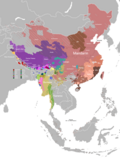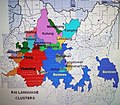The Kiranti languages are a major family of Sino-Tibetan languages spoken in Nepal and India (notably Sikkim, Darjeeling, Kalimpong, and Bhutan) by the...
13 KB (1,211 words) - 23:18, 31 July 2024
Maha-Kiranti ('Greater Kiranti') languages are a proposed intermediate level of classification of the Sino-Tibetan languages, consisting of the Kiranti languages...
4 KB (379 words) - 23:03, 12 October 2024
Kirati people (redirect from Kiranti)
The Kirati people, also spelled as Kirant or Kiranti, are Sino-Tibetan ethnolinguistic groups living in the Himalayas, mostly the Eastern Himalaya extending...
31 KB (3,380 words) - 00:01, 4 November 2024
(Lolo-Burmese, Tujia) to polysynthetic (Gyalrongic, Kiranti) languages. While Sinitic languages are normally taken to be a prototypical example of the...
87 KB (8,580 words) - 06:05, 7 November 2024
Rai language may refer to: Rai languages or Kiranti languages, a family of Sino-Tibetan languages spoken in Nepal, India and Bhutan by Rai people. Bantawa...
2 KB (196 words) - 03:00, 19 August 2024
languages of Himachal Pradesh and western Nepal, the Tamangic languages of western Nepal, including Tamang with one million speakers, and the Kiranti...
40 KB (3,515 words) - 04:55, 18 September 2024
Dhimalish to be particularly closely related to the Kiranti languages rather than to the Sal languages. Grollmann & Gerber (2017) consider Lhokpu to have...
9 KB (350 words) - 22:17, 10 June 2024
people still speak the language, out of 17,003 ethnic Yakkha in Nepal. Genealogically, Yakkha belongs to the Eastern Kiranti languages and is in one subgroup...
18 KB (2,012 words) - 06:48, 20 January 2024
Kulung (autonym: Kulu riŋ, [kulu rɪŋ]) is one of the Kiranti languages. It is spoken by an estimated 33,000 people. Van Driem (2001) includes Chukwa as...
13 KB (560 words) - 00:09, 18 September 2024
kõich; other spellings are Koinch and Koincha), is a Kiranti language of the Sino-Tibetan language family spoken in Nepal and India by the Sunuwar people...
26 KB (2,216 words) - 23:02, 12 October 2024
their language "Camling") and Puma languages of the Kiranti language family in eastern Nepal, and it belongs to the broader Sino-Tibetan language family...
8 KB (640 words) - 10:14, 6 September 2024
the Kiranti languages (Bahing–Vayu and perhaps the Newar language); the Tani languages; the Bodo–Garo languages and perhaps the Konyak languages); the...
6 KB (599 words) - 06:01, 19 August 2024
of the Bahing ethnic group in Nepal. It belongs to the family of Kiranti languages, a subgroup of Sino-Tibetan. The group Rumdali is also known as Nechali...
7 KB (357 words) - 03:38, 19 October 2024
groups of the Himalayas. Kirat may also refer to: Kirat or Kiranti languages, the language of the Kirati Kirat Mundhum, the religion of the Kirati Kirat...
1 KB (219 words) - 22:15, 6 August 2023
region. The Sino-Tibetan languages includes Tamang, Newari, Magar language, Gurung language, Kiranti languages and Sherpa language and are often spoken in...
24 KB (2,124 words) - 12:09, 19 November 2024
The Tani language, often referred to as Tani languages, encompasses a group of closely related languages spoken by the Tani people in the northeastern...
15 KB (1,500 words) - 04:22, 4 August 2024
Rai people (redirect from Rai Languages)
performance. The Rai languages are members of the Sino-Tibetan language family. They belong to the Kiranti group of the Tibeto-Burman languages branch of the...
75 KB (8,674 words) - 21:47, 29 October 2024
is a Kiranti language spoken in Solukhumbu district, Nepal and Sikkim, Darjeeling, and Kalimpong in India. It is one of the few Kiranti languages with...
11 KB (841 words) - 06:02, 20 January 2024
romanized: Vāmbulē) is a Kiranti language language spoken by the Wambule Rai, one of the Rai groups belonging to the Kiranti (किरान्ती) ethnolinguistic...
10 KB (1,278 words) - 15:58, 23 October 2024
Sino-Tibetan language family. George van Driem (2001:804) notes that Lhokpu, although unclassified, may be more closely related to the Kiranti languages than...
4 KB (337 words) - 18:55, 31 October 2024
and more distantly related to the Kiranti languages. George van Driem also classifies Magar Kham as “Para-Kiranti,” emphasizing that Magar Kham, Magar...
27 KB (2,349 words) - 11:30, 26 August 2024
Sampang language is a subgroup of Central Kiranti languages. Sampang is spoken in the following locations of Nepal (Ethnologue). Khotang District, Koshi...
2 KB (109 words) - 18:11, 2 June 2024
Bantawa Language (also referred to as An Yüng, Bantaba, Bantawa Dum, Bantawa Yong, Bantawa Yüng, Bontawa, Kirawa Yüng), is a Kiranti language spoken in...
14 KB (702 words) - 16:45, 25 September 2024
roughly between the Western languages Thulung, Khaling and Dumi, on the one side, and the Southern Central Kiranti languages Kulung, Chamling and Bantawa...
3 KB (289 words) - 06:56, 23 October 2024
Dumi is a Kiranti language spoken in the area around the Tap and Rava rivers and their confluence in northern Khotang district, Nepal. It is spoken in...
5 KB (253 words) - 23:50, 15 October 2024
dialect as a Standard Yakthungpan. Yakthungpan (Limbu language) is one of the major languages spoken and written in Nepal, Darjeeling, Kalimpong, Sikkim...
18 KB (1,692 words) - 18:36, 8 November 2024
Kirat Mundhum (redirect from Kiranti Mundhum)
Kirats in their daily lives. Their religious texts also distinguishes each Kiranti tribe from other Kirati and non-Kiratis as well. Kirants practice shamanism...
11 KB (1,225 words) - 11:02, 25 September 2024
Sal language by Glottolog. Sotrug (2015) and Gerber, et al. (2016) consider Dhimalish to be particularly closely related to the Kiranti languages rather...
13 KB (1,219 words) - 02:03, 3 April 2024
the language is under threat and the influence of other languages, particularly Nepali and Bengali, is increasing day by day. The Himalayan Languages Project...
17 KB (1,173 words) - 01:24, 12 October 2024
(2016: 286-287) considers Greater Magaric to be closely related to the Kiranti languages as part of a greater Himalayish branch, and does not consider Himalayish...
3 KB (199 words) - 05:44, 20 January 2024












